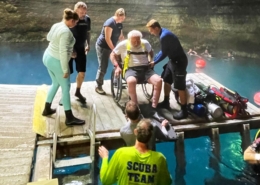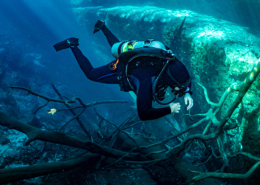How BCD’s Transformed Diving Almost Overnight
By James Donaldson
Nearly 400 years ago, an English astronomer slapped a window on a barrel, attached weights to its bottom, and submerged to a depth of 60 feet in the River Thames. He wasn’t the first to dive in this rudimentary form of underwater life support system. The device, a diving bell, had already been in existence for at least a thousand years. But the man was the first to significantly enhance the diving bell with a window for viewing the underwater world and a portable air supply via a barrel.
That astronomer’s name was Edmond Halley. You’ve probably heard of the comet he found. At the time of his dive in 1690, Halley probably knew that modern humans would see it again in 1986, and that many of us reading this post would see it again in 2061. But he probably couldn’t have predicted the rise of underwater life support systems that a diver could wear as a vest—the BCD.
The vest that changed diving
Short for buoyancy compensator (diving), the first recreational BCD hit the market in 1970, and it’s safe to say the invention transformed diving.
Instead of a window, modern divers use a mask. Air tanks have taken the place of a wooden barrel filled with oxygen, and the BCD—more often called a diving vest—has replaced the ropes, pulleys, and weights that controlled Edmond Halley’s depth in his diving bell. The complicated task of staying neutrally buoyant has been boiled down to the press of a button or valve, and that’s all thanks to the BCD.
BCD’s work by filling a bladder with gas from your tank. This raises and lowers your depth, enabling you to hover over a reef or a wreck at a specific depth in the same way that a fish can. It’s no coincidence that fish also swim to achieve the same results, though they obviously don’t need a vest to do it.
Types of BCDs and Things to Know
In the four decades since its inception, the BCD has settled into two basic forms—the jacket or vest, and “wings.” Both work using the same principles. If you’ve rented your diving gear or learned to dive via a Discover SCUBA experience, you’ve almost certainly worn a BCD jacket. Technical divers prefer wings, but for most recreational divers, a jacket, which wraps around the diver’s torso, will serve them well.

If you’re new to diving and plan to use your new certification to dive often, it’s a good idea to consider investing in your own, personal BCD. When deciding which one to buy, keep a few factors in mind:
- Men and women have different body types, and gender-specific scuba BCD’s are available from most major manufacturers. Women’s BCD’s are specifically designed for the typically shorter torsos and backs that female divers have. Most also forgo chest straps.
- Don’t worry about looks. While BCD’s are available in a wide range of styles, you should take the same approach here that you might take with running shoes: get the BCD that fits right and performs for your body type. You don’t necessarily need to buy the one that suits your fashion sense.
- Budget for your needs. BCD’s vary in price from around $300 and up. This is one of the most essential pieces of gear for your scuba kit, and it’s no place to cut corners.
Four hundred years after Edmond Halley devised a new device to explore the underwater world, the BCD has helped take underwater mobility to new heights. Halley was able to extend his dive time to a previously unheard of 90 minutes. In 1970, experienced modern divers surpassed that record before Halley’s Comet could fly by a single time, in part, thanks to the BCD.











댓글을 남겨주세요
토론에 참여하시겠어요?언제든지 참여하세요!